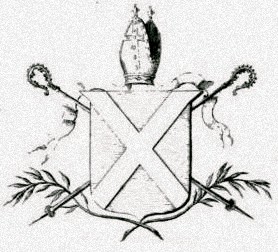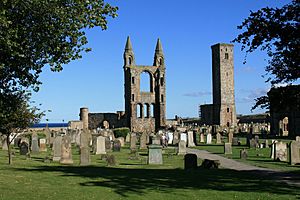Archdiocese of St Andrews facts for kids
 |
|
| Head | Bishop of St Andrews |
|---|---|
| Archdeacon(s) | St Andrews, Lothian |
| First attestation | Early Middle Ages |
| Metropolitan before 1472 | None |
| Metropolitan after 1492 | None |
| Cathedral | St Andrews Cathedral |
| Dedication | Andrew |
| Native dedication | Riagal (Regulus) |
| Mensal churches | Cranston, Edzell, Fettercairn, Forteviot, Inchbrayock, Inchture, Kilmany, Kinnell, Kirkliston, Lasswade, Monimail, Nenthorn, Scoonie, Stow of Wedale, Tannadice, Tyninghame |
| Common churches | [Priory] Abercrombie, Auldcathy, Binning, Bourtie, Conveth, Cupar, Dairsie, Dull, Ecclesgreig, Fordoun, Forgan, Foss, Fowlis-Easter, Grantully, Haddington, Inchture, Kennoway, Kilgour, Kinnedar, Lathrisk, Leuchars, Linlithgow, Longforgan, Markinch, Meigle, Migvie, Muckersie, Portmoak, Rossie, St Andrews Holy Trinity, St Andrews St Leonard's, Scoonie, Strathmiglo, Tannadice, Tarland, Tealing, Tyninghame |
| Prebendal churches | Currie (archdeacon of Lothian), Kinneff (Archdeacon of St Andrews), Rescobie (archdeacon of St Andrews), Tarvit (archdeacon of St Andrews) |
| Catholic successor | Roman Catholic Archdiocese of St Andrews and Edinburgh |
| Episcopal successor | Diocese of Saint Andrews, Dunkeld and Dunblane & Diocese of Edinburgh |
The Archdiocese of St Andrews was a very important part of the Catholic Church in Scotland during the Middle Ages and early modern times. It was first known as the Diocese of St Andrews. This area was the biggest, had the most people, and was the wealthiest church region in medieval Scotland. It covered a large part of eastern Scotland, from the border with England all the way up to Aberdeenshire.
Even though it didn't become an archdiocese until 1472, St Andrews was seen as the main church center in Scotland from at least the 11th century. By the early 1500s, it became one of two archdioceses in Scotland. It oversaw several other bishoprics, including Aberdeen, Brechin, Caithness, Dunblane, Dunkeld, Moray, Orkney, and Ross.
Contents
Origins of the Diocese
Some old records say that King Óengus II of the Picts (who died in 834) founded the church at St Andrews. However, a record from 747 mentions an abbot (a leader of a monastery) from St Andrews. This was about 70 years before King Óengus II ruled. This earlier record is the oldest written proof we have for St Andrews. It's possible the church was founded during the time of King Óengus I, who ruled around then.
Historians like James Fraser have pointed out that important churches in England, like Canterbury and York, were dedicated to St Peter. Their smaller bishoprics were dedicated to St Andrew. This might mean St Andrews was set up as a bishopric from the start, perhaps as a junior one to the bishopric of Rosemarkie. The rise of the worship of St Andrew in the 700s might also be linked to the name "Constantine" becoming popular for kings, as St Andrew was the patron saint of Constantinople.
Bishops of the Scots
The leader of the diocese, the Bishop of St Andrews, became known as the most important church official in Scotland. They were ranked above the bishops of Glasgow, Dunkeld, and Aberdeen. An old account from the 1100s describes how these bishops were called "High Archbishops" or "High Bishops of the Scots." For example, a very important bishop named Fothad had these words written on a gospel book cover: "Fothad, who is High Bishop of the Scots, made this cover for an ancestral gospel-book." In everyday language, they were called Escop Alban, which means "Bishops of Alba" (Alba was an old name for Scotland).
Around this time, the archbishop of York in England claimed that the Scottish bishoprics north of the River Forth should be under his control. This was part of the larger Latin Church structure. However, Scotland north of the Forth had never been part of the Roman Empire or Anglo-Saxon England. This made it hard for York to prove its claim. Even so, it was understood that Britannia (Britain) should have two archbishops in the Latin church system. Some Scottish records from the time of Bishop Giric (around 1100) even called St Andrews an "apostolic see" and the "second Rome."
In 1120, King Alexander I of Scotland appointed an Englishman named Eadmer from Canterbury to St Andrews. But Eadmer had to step down soon after. King Alexander I would not agree to make the bishopric part of the English church under Canterbury. Although Scottish-born bishops led the diocese until the late 1000s, there were no Scottish-born bishops again until David de Bernham in 1239. Despite this, the Scottish church resisted pressure from York and Canterbury, even when it came from the Pope and the English king. Scotland asked the Pope to make St Andrews an archbishopric, but this didn't happen right away. However, in 1192, the Scottish bishoprics were officially recognized as independent.
In 1472, Scotland gained control of the Norðreyjar (Orkney and Shetland Islands). These islands had been promised by the King of Norway as security for a dowry that was never paid. Because of this, the diocese of Caithness, which was part of the Archdiocese of Niðaróss (in Norway), was moved to be under St Andrews. At this point, St Andrews officially became an archbishopric, recognized by the Pope.
Size and Possessions
In the late 1200s, church officials from the Pope estimated the diocese's income to be over 8,000 pounds. This was twice the income of the diocese of Glasgow. St Andrews was the largest diocese in medieval Scotland in terms of land. It stretched from Berwick-upon-Tweed in the south to Nigg on the River Dee near Aberdeen. Like many other Scottish dioceses, its land was not always connected. Some areas of other bishoprics, like Aberdeen, Dunblane, and Dunkeld, were located within St Andrews' territory. The entire diocese of Brechin was also completely surrounded by St Andrews.
The bishops of St Andrews had a castle in St Andrews itself. They also owned fortified manors (large estates with strong houses) throughout their diocese. These were strengthened during the time of William de Lamberton. These included Inchmurdo, Dairsie, Monimail, Torry, Kettins, and Monymusk north of the Forth River. South of the Forth, they had Stow of Wedale, Lasswade, and Liston in Lothian. There was also an important manor at Tyninghame near Dunbar.
When St Andrews became an archdiocese in 1472, the other 12 Scottish bishoprics became its suffragans (meaning they were under its authority). However, in 1492, the diocese of Glasgow also became an archbishopric. This meant that Dunkeld, Dunblane, Argyll, and Galloway (as well as Glasgow itself) were no longer under St Andrews. Within a few decades, Dunkeld and Dunblane returned to St Andrews' authority. Later, the bishopric of the Isles was transferred to Glasgow.
Organisation
By the year 1300, the diocese of St Andrews had 232 known parish churches. It was divided into two main areas called archdeaconries, which were then split into smaller areas called deaneries.
Archdeaconry of St Andrews
This archdeaconry included several deaneries:
Deanery of Angus
Deanery of Fife
Deanery of Fothriff
Deanery of Gowrie
Deanery of Mearns
Archdeaconry of Lothian
This archdeaconry also included several deaneries:
Deanery of Haddington
Deanery of Linlithgow
Deanery of Merse
Office holders
Bishops and archbishops
Cathedral priors
Archdeacons
See also
- Roman Catholic Archdiocese of St Andrews and Edinburgh
- Scottish Episcopal Church Diocese of St Andrews, Dunkeld and Dunblane



